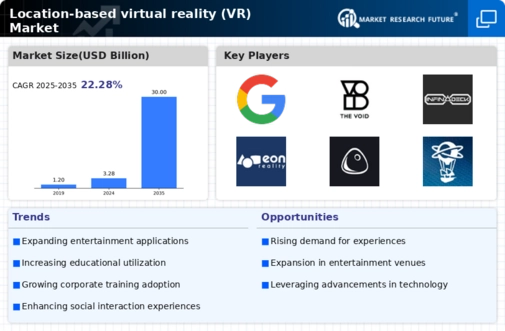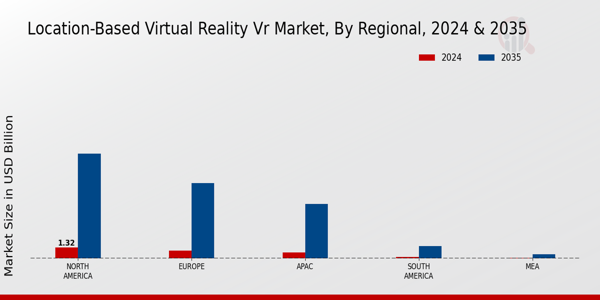Market Growth Projections
The Global Location-based virtual reality (VR) Market Industry is poised for substantial growth, with projections indicating a market value of 3.28 USD Billion in 2024 and an anticipated increase to 30 USD Billion by 2035. This growth trajectory suggests a robust expansion driven by various factors, including technological advancements, increasing consumer demand, and the integration of VR in diverse sectors. The market is expected to experience a compound annual growth rate (CAGR) of 22.29% from 2025 to 2035, reflecting the growing interest and investment in location-based VR solutions. This upward trend underscores the potential for innovation and development within the industry.
Rising Popularity of VR Entertainment
The Global Location-based virtual reality (VR) Market Industry is significantly influenced by the rising popularity of VR entertainment experiences. As consumers seek novel forms of entertainment, VR gaming and immersive experiences in theaters and arcades are gaining traction. The integration of VR technology into mainstream entertainment is attracting a diverse audience, from casual gamers to dedicated enthusiasts. For example, VR escape rooms and interactive storytelling experiences are becoming increasingly popular, drawing in crowds and generating substantial revenue. This growing interest in VR entertainment is expected to contribute to the market's expansion, with a projected value of 3.28 USD Billion in 2024.
Expansion of VR in Education and Training
The Global Location-based virtual reality (VR) Market Industry is experiencing significant growth due to the increasing adoption of VR in education and training sectors. Educational institutions and corporations are leveraging VR technology to create immersive learning environments that enhance knowledge retention and engagement. For instance, medical schools utilize VR simulations for surgical training, allowing students to practice in a risk-free environment. This trend is expected to expand as more organizations recognize the benefits of VR in skill development and training. The market is projected to grow at a CAGR of 22.29% from 2025 to 2035, reflecting the rising demand for innovative educational solutions.
Technological Advancements in VR Hardware
Advancements in VR hardware technology are propelling the Global Location-based virtual reality (VR) Market Industry forward. Innovations such as improved headsets, motion tracking systems, and haptic feedback devices enhance the user experience, making VR more accessible and appealing. Companies are increasingly adopting these technologies to create more realistic and engaging environments for users. For example, the introduction of wireless VR headsets has eliminated the constraints of wired connections, allowing for greater freedom of movement. This technological evolution is likely to drive market growth, as enhanced hardware capabilities attract more users and businesses to invest in location-based VR solutions.
Increasing Demand for Immersive Experiences
The Global Location-based virtual reality (VR) Market Industry is witnessing a surge in demand for immersive experiences across various sectors, including entertainment, education, and tourism. As consumers increasingly seek engaging and interactive content, businesses are investing in location-based VR solutions to enhance customer experiences. For instance, VR arcades and theme parks are becoming popular destinations, offering unique attractions that leverage VR technology. This trend is expected to contribute to the market's growth, with projections indicating a market value of 3.28 USD Billion in 2024, potentially reaching 30 USD Billion by 2035.
Collaborations and Partnerships in the VR Ecosystem
Collaborations and partnerships among technology providers, content creators, and location-based VR operators are shaping the Global Location-based virtual reality (VR) Market Industry. These alliances enable companies to combine their expertise and resources, resulting in innovative VR solutions that enhance user experiences. For instance, partnerships between gaming companies and VR hardware manufacturers facilitate the development of exclusive content tailored for specific platforms. Such collaborations are likely to drive market growth by expanding the range of available experiences and attracting new users. As the industry evolves, these strategic alliances will play a crucial role in shaping the future of location-based VR.
























